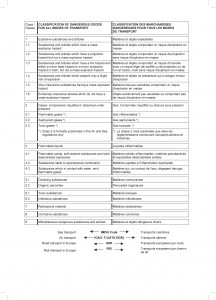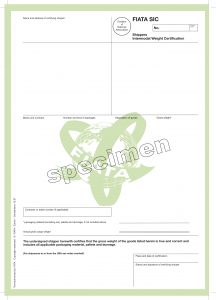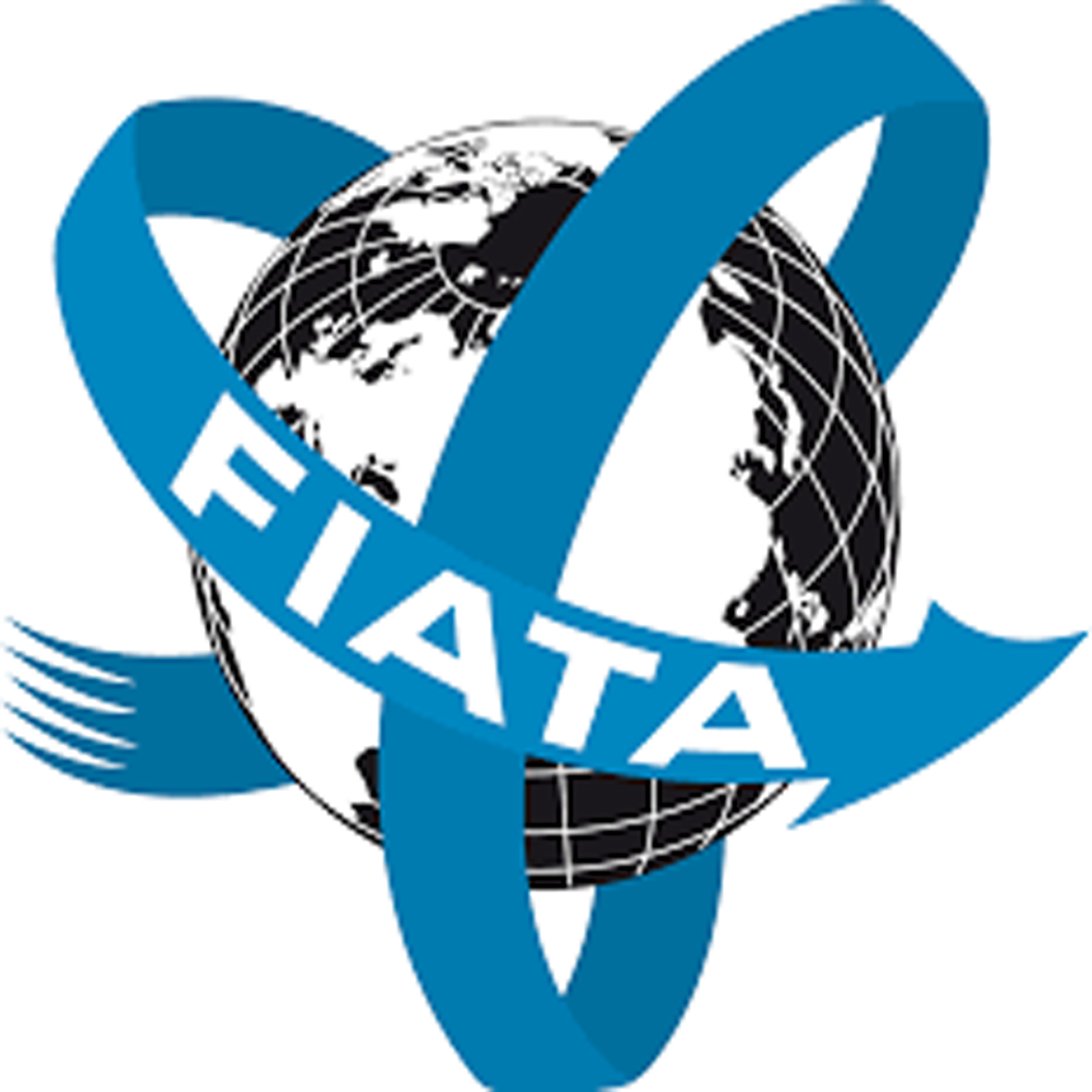Contents
1-FIATA FCR (Forwarders Certificate of Receipt)
2-FIATA FCT (Forwarders Certificate of Transport)
3-FWR (FIATA Warehouse Receipt)
4-FBL (Negotiable FIATA Multimodal Transport Bill of Lading)
5-FWB (Non-Negotiable FIATA Multimodal Transport Waybill)
6-FIATA SDT (Shippers Declaration for the Transport of Dangerous Goods)
7-FIATA SIC (Shippers Intermodal Weight Certification)
8-FFI (FIATA Forwarding instructions)
1-FIATA FCR (Forwarders Certificate of Receipt)

The Forwarder’s Certificate of Receipt was introduced by FIATA for the use by international freight forwarders
which are members of FIATA’s association members. The FIATA FCR document enables the freight forwarder to provide the consignor with a special document as an official acknowledgement that he/she has assumed responsibility of the goods.
The FIATA FCR can be handed over to the consignor immediately after the freight forwarder has received the consignment.
By completing the FIATA FCR the freight forwarder certifies that he/she is in possession of a specific consignment, with irrevocable instructions for dispatch to the consignee shown in the document, or for keeping it at the consignor’s disposal if the consignee is not specified. These instructions may only be cancelled if the original FIATA FCR document is handed over to the issuing freight forwarder and only if it is in a position to
comply with such cancellation or alteration.
The FIATA FCR will primarily be used when the supplier sells the goods ex works and needs to prove that
it has complied with its obligations to the buyer by presenting a FIATA FCR. In the case of a Letter of Credit
the seller will under such conditions be able to present a FIATA FCR issued by a forwarder in order to obtain
payment of the sales price placed at its disposal by the buyer under the terms of the Letter of Credit. The seller can no longer dispose of goods handed over to the forwarder once the FIATA FCR document has been
handed over to the buyer.
The FIATA FCR is not negotiable. As the delivery of the consignment to the consignee does not depend on the handing over of this document, only one original is issued. Should further copies be required, forms
specially overprinted with the words “Copy” should be used.
When issuing a FIATA FCR, the freight forwarder should ensure that:
1- He or she has taken over the goods specified therein and that the right of disposal of these goods is
vested solely in him/her;
2- the goods appear to be in apparent good order and condition;
3- the details on the document clearly correspond with the instructions he or she has received; and
4- the conditions of freight documents (B/L, etc.) are not contrary to the obligations he or she has assumed according to the FIATA FCR document.
The FIATA FCR ordinarily bears the general conditions of the issuing country or territory on the reverse. The document may only be used by freight forwarders who adhere to these general conditions and applicable law in their forwarding activities. It is recommended that the freight forwarder covers its liability by insurance in accordance with the FIATA FCR requirements and the applicable law.
2-FIATA FCT (Forwarders Certificate of Transport)

The Forwarder’s Certificate of Transport was introduced by FIATA for the use by international freight forwarders which are members of FIATA’s association members.
By issuing a FIATA FCT document to the consignor, the freight forwarder assumes the obligation to arrange delivery of the goods at destination through an agent appointed by him/her. The FIATA FCT can be handed over to the consignor immediately after the consignment has been handed over to the freight forwarder for shipment.
By issuing the FIATA FCT the freight forwarder certifies that he/she has assumed responsibility for organizing the dispatch and delivery of specific goods according to instructions he/she has received from the consignor as indicated in the document.
The freight forwarder is responsible to ascertain the delivery of the goods at destination through a delivery agent appointed by him/her in the interest of the holder of the document in accordance with the conditions stipulated on the reverse of the FIATA FCT.
he FIATA FCT has a “block” function. The freight forwarder is only responsible for the forwarding services required for delivery of the goods. The FIATA FCT, as distinguished from the FBL, is not a document subjecting the freight forwarder to a liability as carrier but his/ her liability is governed by the applicable freight forwarding conditions.
The FIATA FCT will therefore be of importance in all cases where the transport has to be arranged for delivery to the consignee. The seller will be able to obtain payment of the selling price from his/her bank against the FIATA FCT when used with the “Cash Against Documents” procedure.
The FIATA FCT is negotiable when made out “To Order” (see also ICC Doc. 470/251 Art. 24).
e FIATA FCT is negotiable, as the delivery of the consignment may only be effected against presentation of
the original document, duly endorsed.
when issuing the FIATA FCT document the freight forwarder should ensure that:
1- he/she has taken control of the goods specified therein and that the right of disposal of these goods is
vested solely in him/her;
2- the goods appear to be in apparent good order and condition;
3- the details on the document clearly correspond with the instructions he/she has received;
4- the conditions of freight documents (B/L, etc.) are not contrary to the obligations he/she has assumed according to the FIATA FCT document;
5- the responsibility for the insurance of the goods has been agreed; and
6- It is clearly specified whether one or more originals have been issued.
It is recommended to dispatch the FIATA FCT negotiable documents by a courier service or other means that
ensures the proof of receipt.
The FIATA FCT should bear the general conditions of the issuing country or territory on the reverse. The document may only be used by freight forwarders who adhere to these general conditions in their forwarding
activities.
Great care must be taken in the preparation of these documents as the particulars contained therein must reflect accurately the full details of the consignment.
3- FWR (FIATA Warehouse Receipt)

The freight forwarder often provides warehousing services. When doing so he/she has to issue a receipt for the merchandise.
The FWR is a Warehouse Receipt for use in freight forwarders’ warehousing operations. It is a standard document mainly used at national/territorial level.
The FWR is not a warehouse warrant, which means a formal document recognized as warrant according to the applicable law. When a warehouse keeper is requested to issue a warehouse warrant, the FWR cannot be used. If the issue of a legally recognized document of this kind is not required, the FWR can be issued in almost all cases. Its commercial character is practically the same as that of a warehouse warrant. The FWR incorporates detailed provisions regarding the rights of the holders-by-endorsement of the document, the transfer of ownership and the agreement that presentation of the warehouse receipt amounts to good delivery of the merchandise. For all practical purposes, such legal functions intended by the use of the FWR are recognized in most jurisdictions.
the FWR is not negotiable, unless it is marked “negotiable” on its face.
It must be decided individually in each country or territory, which standard trading conditions are to be applied to the FIATA Warehouse Receipt or which provisions of the law apply. In countries or territories where forwarders use standard trading conditions, which also include provisions regarding the activity of warehouse keepers, such standard conditions apply.
4-FBL (Negotiable FIATA Multimodal Transport Bill of Lading)


The FIATA Multimodal Transport Bill of Lading (FBL) is a carrier-type transport document set up by FIATA for the use by freight forwarders acting as Multimodal Transport Operators (MTO).
The FBL can also be issued as a marine bill of lading.
e document is negotiable unless marked “non-negotiable”. It has been deemed by the International Chamber of Commerce (ICC) to be in conformity with the UNCTAD/ICC Rules for Multimodal Transport Documents published by ICC in its brochure No. 481. Therefore, the FBL bears the ICC logo alongside the symbol of the relevant freight forwarders association by country or territory.
e negotiable FIATA Multimodal Transport Bill of Lading (FBL) conforms to the requirements of the “Guide for the Uniform Customs and Practice for Documentary Credits (UCP 600)” of ICC (ICC publication No. 600) when issued as multimodal transport document in line with Article 19 or as bill of lading in line with Article 20, as an acceptable transport document.
A freight forwarder acting as Multimodal Transport Operator (MTO) or marine carrier issuing a FBL is responsible for the performance of transport. The freight forwarder does not only assume responsibility for delivery of the goods at destination, but also for all carriers and third parties engaged by him/her for the performance of the whole transport, including delivery.
By issuing a FBL the freight forwarder accepts a basic liability limit of 666.67 SDR per package or unit, or 2 SDR per kilogram of gross weight of the goods lost or damaged, whichever is the higher (Art. 8.3 of the FBL conditions), or, if a multimodal transport does not include carriage of goods by sea or inland waterways, a basic liability limit of 8.33 SDR per gross weight (Art. 8.5 of the FBL conditions). When loss of or damage to the goods can be attributed to a particular stage of transport in a multimodal transport operation, the freight forwarder’s liability is limited according to mandatory national or international law applicable to this stage of transport (Art. 8.6.a of the FBL conditions).
when issuing an FBL, the freight forwarder should ensure :
1- that he/she has taken over the goods specified therein and that the right of disposal of these goods is
solely vested in him/her;
2- that the goods appear to be in apparent good order and condition;
3- that details on the document correspond with the instructions he/she has received;
4- that responsibility for cargo insurance cover has
been agreed upon with the consignor; and
5- that it is clearly specified how many original FBLs
are issued.
Freight forwarders issuing FBLs have to insure their liability in accordance with the FBL conditions.
5-FWB (Non-Negotiable FIATA Multimodal Transport Waybill)


The FIATA Multimodal Transport Waybill (FWB) is a carrier-type transport document set up by FIATA for the use by freight forwarders acting as Multimodal Transport Operators (MTO).
The FWB can also be used as sea waybill.
The document is not negotiable. It has been deemed by the International Chamber of Commerce (ICC) to be in conformity with the UNCTAD/ICC Rules for Multimodal Transport Documents published by ICC in its brochure No. 481. Therefore, the FWB bears the ICC logo alongside the symbol of the national/regional freight forwarders association.
he non-negotiable FIATA Multimodal Transport Waybill (FWB) conforms to the requirements of the “Guide for the Uniform Customs and Practice for Documentary Credits (UCP 600)” of ICC (ICC publication No. 600) in line with Article 21 when issued as a sea waybill, as an acceptable transport document. A freight forwarder acting as MTO or marine carrier issuing the FWB is responsible for the performance of transport. The freight forwarder does not only assume responsibility for choosing the agents for the delivery of the goods at destination, but also for all carriers and
third parties engaged by him/her for the performance of the entire transport. Contrary to the FIATA Multimodal Transport Bill of Lading (FBL), the FWB need not be presented by the consignee for the delivery of the goods at destination.
By issuing a FWB, under the terms on the reverse of the document, the freight forwarder generally accepts a basic liability limit of 666.67 SDR per package or unit, or 2 SDR per kilogram of gross weight of the goods lost or damaged, whichever is the higher, unless a higher value has been declared (Art. 9.3. of the FWB conditions). If a multimodal transport does not include carriage of goods by sea or inland waterway, a basic liability limit of 8.33 SDR per kilogram gross weight (Art. 9.5. of the FWB conditions) applies. When loss of or damage to the goods can be attributed to a particular stage of transport in a multimodal transport operation, the freight forwarder’s liability is limited according to mandatory national, territorial, or international law applicable to this stage of transport (Art. 9.6. a of the FWB conditions).
when issuing a FWB, the freight forwarder should ensure that:
1- he/she has taken over the goods specified therein
and that the right of disposal of these goods is solely
vested in him/her
2- the goods appear to be in apparent good order and condition;
3- details on the document correspond with the instructions he/she has received; and
4- responsibility for the cargo insurance cover has been agreed upon with the consignor.
Freight forwarders issuing FWBs have to insure their liability in accordance with the FWB conditions.
6-FIATA SDT (Shippers Declaration for the Transport of Dangerous Goods)


f a freight forwarder deals with the transport of dangerous goods, he/she needs detailed information with
regard to the classification of the goods, according to the dangerous goods regulations for the different modes of transport. The FIATA SDT can be used for road transport in countries that have adopted the ADR, and sea transport where the IMDG Code is in effect. In addition, the form could assist in the carriage of dangerous goods according to other national or local legislation, where additional documentary requirements may apply and need to be ascertained before the movement of the goods.
The FIATA SDT is not accepted for international rail transport according to RID and air transport according
to the ICAO Technical Instructions. For rail transport (RID) the CIM waybill must be used with suitable no-tations compliant with the applicable RID rules, and for air transport forms and additional requirements stipulated in the IATA Dangerous Goods Rules apply. However, the correctly filled FIATA SDT can always be utilized as a complementary document.
the Shipper’s Declaration shall not be completed by the freight forwarder. In each case, the Declaration must be completed and signed by the shipper (consignor) and then handed over to the freight forwarder.
further helpful information regarding the regulations for the transport of dangerous goods and responsibilities is contained in the brochure “FIATA Introduction to the Regulations for the Safe Handling and Transport of Dangerous Goods”. Additional information is available on the FIATA website (www.fiata.com) and information
published by the UN is updated every second year (United Nations’ Recommendations on the Transport of Dangerous Goods – Model Regulations).

The starting point for the creation of the FIATA SIC was the Intermodal Safe Container Act of 1992 in the USA
and the Amendment to the Act of 1996. The FIATA SIC facilitates freight forwarders’ and shippers’ compliance
with US legislation, which provides in US trades for certification of the gross cargo weight stowed in a container or trailer if it exceeds 29’000 pounds (13’154 kg).
goods originate from a single shipper, the FIATA SIC must be completed and signed by him/her and be handed over to the freight forwarder to enable the freight forwarder to pass on the information contained in the form to the carrier. When arranging consolidated container shipments, the freight forwarder becomes a shipper himself/herself. If the total gross cargo weight is in this case expected to exceed 29’000 Pounds (13’154 kg), it is advisable for the freight forwarder to obtain from all initial shippers FIATA SICs to be able to base his/her own document on their certifications.
Although the form was designed in compliance with the overweight container legislation of the USA, it can also
be used for shipments to other places where weight certification may be necessary or recommendable. In
particular its use can be advantageous in preparation of the entry into force of the mandatory rules on container weighing decided by the IMO.
8-FFI (FIATA Forwarding instructions)

Freight forwarders mostly design and print their own forwarding instructions forms, which have to be filled in by their clients. However, the instruction forms of the various freight forwarders are not uniform.
In the interest of uniformity and a common layout FIATA drafted the FIATA Model for Forwarding Instructions. The form is aligned to the UN layout key for trade documents (UNCEFACT recommendation number 1), which aims at providing an international basis for the standardization of documents used in international trade.
The form is designed to be used in the aligned series and to combine functions in sets of forms, of which integral parts serve various purposes in the procedures for cargo handling.
ember organizations of FIATA may adapt this instruction form to their national/regional requirements.
However, it is fundamental that such changes are made within the margin of the UN layout key.
IATA recommends that its Association Members adopt and introduce this instruction form, as it is an important tool to improve professional standards and will serve to foster the corporate identity of our trade. It is worth noting that the mapping of these forms in the digital environment exists and is available for developers.
Source : International Federation of Freight Forwarders Associations





